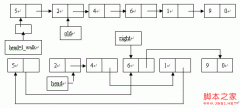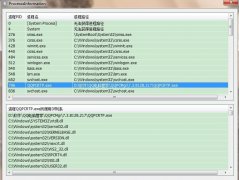让TList类型安全
在VCL中包含有一个TList类,相信很多朋友都使用过,它可以方便的维护对象指针,所以很多朋友都喜欢用它
来实现控件数组。不幸的是,这个TList类有一些问题,其中最重要就是缺乏类型安全的支持。
这篇文章介绍如何从TList派生一个新类来实现类型安全,并且能自动删除对象指针的方法。
TList的问题所在
对于TList的方便性这里就不多说,我们来看一下,它到底存在什么问题,在Classes.hpp文件中,我们可以看到函数的原型是这样申明的:
int __fastcall Add(void * Item);
编译器可以把任何类型的指针转换为void*类型,这样add函数就可以接收任何类型的对象指针,这样问题就来了,假如你仅维护一种类型的指针也许还看不到问题的潜在性,下面我们以一个例子来说明它的问题所在。假设你想维护一个TButton指针,TList当然可以完成这样的工作但是他不会做任何类型检查确保你用add函数添加的一定是TButton*指针。
TList *ButtonList = new TList; // 创建一个button list
ButtonList->Add(Button1); // 添加对象指针
ButtonList->Add(Button2); //
ButtonList->Add( new TButton(this)); // OK so far
ButtonList->Add(Application); // Application不是button
ButtonList->Add(Form1); // Form1也不是
ButtonList->Add((void *)534);
ButtonList->Add(Screen);
上面的代码可以通过编译运行,因为TList可以接收任何类型的指针。
当你试图引用指针的时候,真正的问题就来了:
TList *ButtonList = new TList;
ButtonList->Add(Button1);
ButtonList->Add(Button2);
ButtonList->Add(Application);
TButton *button = reinterpret_cast
button->Caption = "I hope it's really a button";
delete ButtonList;
相信你已经看到了问题的所在,当你需要取得指针引用的时候TList并不知道那是个什么类型的指针,所以你需要转换,但谁能保证ButtonList里一定是Button指针呢?你也许会马上想到使用dynamic_cast来进行转化。
不幸再次降临,dynamic_cast无法完成这样的工作,因为void类型的指针不包含任何类型信息,这意味着你不能使用这样的方法,编译器也不答应你这样做。
dynamic_cast不能使用了,我们唯一的方法就是使用reinterpret_cast,不过这个操作符同以前c的强制类型转换没有任何区别,它总是不会失败,你可以把任何在任何指针间转换。这样你就没有办法知道List中是否真的是我们需要的Button指针。在上面的代码片断中,问题还不是非常严重,我们试图转换的指针是Application,当我们改变Caption属性的时候,最多把标题栏的Caption属性改了,可是假如我们试图转换的对象没有相应的属性呢?
TList的第二个问题是,它自动删除对象指针的功能,当我们析构TList的时候,它并不能自动释放维护的指针数组的对象,很多时候我们需要用手工的方法来完成这样一件事情,下面的代码片断显示了如何释放他们:
TList *ButtonList = new TList; // create a list of buttons
ButtonList->Add(new TButton(Handle)); // add some buttons to the list
ButtonList->Add(new TButton(Handle));
ButtonList->Add(new TButton(Handle));
ButtonList->Add(new TButton(Handle));
...
...
int nCount = ButtonList->Count;
for (int j=0; j delete ButtonList->Items[j]; delete ButtonList; (译注:上面的代码有问题,应该是for(int j=nCount-1;j>=0;j--),及要反过来循环,否则可能出现AV) 表面上看来,上面的代码能很好的工作,但是假如你深入思考就会发现潜在的问题。Items[j]返回的是一个void指针,这样delete语句将会删除void指针,但是删除void指针与删除TButton指针有很大的不同,删除void指针并不会调用对象的析构器,这样存在于析构器中的释放内存的语句就没有机会执行,这样将造成内出泄漏。 完了能完全的删除对象指针,你必须让编译器知道是什么类,才能调用相应的析构器。好在VCL的析构器都是虚拟的,你可以通过转换为基类来安全的删除派生类。比如假如你的List里包含了Button和ComboBox,有可以把他们转换为TComponent、TControl、TWinControl来安全的删除他们,示例代码如下: TList *ControlList = new TList; ControlList->Add(new TButton(Handle)); ControlList->Add(new TEdit(Handle)); ControlList->Add(new TComboBox(Handle)); int nCount = ControlList->Count; for (int j=nCount; j>=0; j--) delete reinterpret_cast delete ControlList; 上面的代码可以安全的删除任何从TwinControl派生的子类,但是假如是TDatset呢?TDataSet并不是从TWinControl继续的,这样delete将调用TWinControl的析构器,这同样可能造成运行时的错误。 改进TList 通过上面的论述,我们已经大概了解了TList需要如何改进。假如TList知道它处理的对象的类型,大多数的问题就解决了。下面的代码就是为了这个目标来写的: #ifndef TTYPEDLIST_H #define TTYPEDLIST_H #include template class TTypedList : public TList { private: bool bAutoDelete; protected: T* __fastcall Get(int Index) { return (T*) TList::Get(Index); } void __fastcall Put(int Index, T* Item) { TList::Put(Index,Item); } public: __fastcall TTypedList(bool bFreeObjects = false) :TList(), bAutoDelete(bFreeObjects) { } // 注重:没有析构器,直接调用Delete来释放内存 // 而且Clean时虚拟的,你知道怎么做了? int __fastcall Add(T* Item) { return TList::Add(Item); } void __fastcall Delete(int Index) { if(bAutoDelete) delete Get(Index); TList::Delete(Index); } void __fastcall Clear(void) { if(bAutoDelete) { for (int j=0; j delete Items[j]; //(译注:这行代码同样存在上面提到的问题) } TList::Clear(); } T* __fastcall First(void) { return (T*)TList::First(); } int __fastcall IndexOf(T* Item) { return TList::IndexOf(Item); } void __fastcall Insert(int Index, T* Item) { TList::Insert(Index,Item); } T* __fastcall Last(void) { return (T*) TList::Last(); } int __fastcall Remove(T* Item) { int nIndex = TList::Remove(Item); // 假如bAutoDelete is true,我们将自动删除item if(bAutoDelete && (nIndex != -1)) delete Item; return nIndex; } __property T* Items[int Index] = {read=Get, write=Put}; }; #endif 实例代码 //---------------------------------------------------------------------------- // 示例代码1 #incude "typedlist.h" void __fastcall TForm1::CreateButtons() { // false,不自动删除 TTypedList ButtonList->Add(new TButton(this)); ButtonList->Add(new TButton(this)); ButtonList->Add(new TButton(this)); // ButtonList->Add(Application); <<-- 无法通过编译 for (int j=0; j { ButtonList->Items[j]->Caption = "Button" + IntToStr(j); ButtonList->Items[j]->Left = 250; ButtonList->Items[j]->Top = 50 + j*25; ButtonList->Items[j]->Parent = this; } delete ButtonList; } //---------------------------------------------------------------------------- // 实例代码2 #incude "typedlist.h" void __fastcall TForm1::CreateButtons() { typedef TTypedList TButtonList *ButtonList = new TButtonList(true); ButtonList->Add(new TButton(this)); ... delete ButtonList; } //---------------------------------------------------------------------------- // Code Example 3: A list of tables and queries #incude "typedlist.h" void __fastcall TForm1::OpenDataSets() { typedef TTypedList TDataSetList *list = new TDataSetList(false); list->Add(Table1); list->Add(Table2); list->Add(Table3); list->Add(Query1); for (int j=0; j list->Items[j]->Active = true; delete list; } 通过使用模板技术,我们把问题消灭在了编译时期,而且也提供了自动删除的机制,又由于上面的代码使用了内联技术(inline),所以也没有牺牲代码的效率。 建议你使用STL 通过上面的代码论述,很多初学者可能会害怕,没有类型安全,没有自动删除机制,改代码又那么麻烦,有没有更简单的方法?答案是STL,STL是轻便的,高弹性,高度复用性的,以及类型安全的。假如使用STL,TList的替代品是Vector。
- 上一篇:字符串近似匹配算法
- 下一篇:在CB中如何自定义属性[properties]





